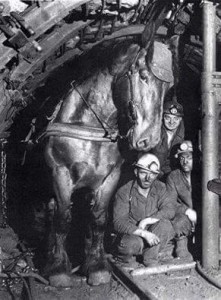History of the Percheron
Photo Credit: “Haras in Saint-Lô , Normandië, France” by Marjon Kruik – originally posted to Flickr as Haras in Saint-Lô , Normandië, France. Licensed under CC BY 2.0 via Commons – https://commons.wikimedia.org
 Across the sea a confident young republic was experiencing the same changes from stage coach to rail, from agrarian to industrial and from sail to steam. The United States was without any breeds of its own. Its horse stocks had been heavily drawn down by its own Civil War in the 1860s. The west was being settled, its cities were growing, and there echoed the same cry for bigger, stronger horses than heretofore, just as in continental Europe.
Across the sea a confident young republic was experiencing the same changes from stage coach to rail, from agrarian to industrial and from sail to steam. The United States was without any breeds of its own. Its horse stocks had been heavily drawn down by its own Civil War in the 1860s. The west was being settled, its cities were growing, and there echoed the same cry for bigger, stronger horses than heretofore, just as in continental Europe.
The only source of such stock was in western Europe. Americans became steady visitors and determined buyers of such seed stock. The initial importation’s of French stock were in 1839 and 1851. None of those first importation’s came from La Perche, but rather from Normandy. Nonetheless, they provided a beginning.
The decades of the 1870s and 80s were years of massive importation’s from Europe. Literally thousands of draft-type horses, especially stallions, were imported primarily from France and Great Britain. A battle was on for the hearts and pocketbooks of American importers.
As the trade grew and importers ventured further inland in search of the best kind, the little old province of Le Perche was discovered. Or, more to the point, the superiority of its draft horses was discovered. For France had and still does, several races (breeds) of draft horses.
The age of purebred livestock had dawned, stud books, herd books, and flock books were rapidly spawned on both sides of the Atlantic. In the winter of 1875-76, in Chicago, Illinois, a National Association of Importers & Breeders of Norman Horses was launched. By the time the 2nd volume of the stud book was published the name was altered to Percheron-Norman. In a matter of just a few years the hyphenated version became simply reference
The Percheron quickly became America’s favorite horse. In the decade of the 80s almost 5,000 stallions and over 2,500 mares were imported to this country from France, mostly from Le Perche. The number exceeded importation’s from Great Britain and the rest of continental Europe.
Those heavenly days, leaving millions of dollars in little Le Perche, lasted until the financial panic of 1893. There were virtually no importations from 1894-1898. Breeding in this country came to a standstill. Much of the seed stock from the earlier period was lost or squandered as people were either broke or too cautious to spend it if they had it. One of the tens of thousands of businesses that went bankrupt was the young Association.
The recovery was almost as abrupt as the downslide. Importations were resumed in 1898, averaging about 700 head a year from that time to 1905. In 1906, they reached the enormous number of 13,000 stallions and 200 mares. Happy Days were here again, both in places like Crossroads, USA and Le Perche. Annual registrations reached 10,000 per year by the teens.
In 1902, a new breed association was formed, picking up the records from the old. These fortuitous circumstances were rudely interrupted in 1914 by the outbreak of World War 1. The days of great importations were over once and for all.
The position and role of the draft horse was being threatened by trucks in the cities and tractors on the farms. The equine population of the Unites States crested about 1920. While the draft horse waged a determined campaign to “keep its job” it was a losing battle, particularly on the city streets. On the farms, the draft animal pretty well held its own during the 1920s, but the decade was a lackluster one for the heavy horse interests. You can’t be loosing a substantial part of your market and be singing Happy Days are Here Again at the same time.
The 1930s census is a good indication of the affection Americans had for the Percheron. Over 70% of the purebred draft horses in America were Percherons. Every major land grant school in America maintained a stable of Percherons. Much of the farm press was still loyal to the horse as the most economical source of farm power.
Then came the great depression of the 1930s and the draft horse made a dramatic comeback. Corn was cheap, farmers were broke, gasoline wasn’t free. Registrations more than doubled in a few short years. In 1937 they reached 4,611, a figure not seen for over a decade. Importations of a few quality horses were resumed on a modest scale. But the tractor had also been improved, put on rubber, and was selling like hot cakes as the decade closed. Then came the 1940s and World War 2 and an almost complete mobilization of manpower. During that war an awful lot of the farming got done by old men and their wives, and high school and younger kids. Gasoline was plentiful. The use of drafters during the war declined. When the veterans came home they were, for the most part, mechanically inclined and their fathers were tired. The greatest liquidation of draft horse stock in history started and kept right on going clear through the 1950s until they were no longer considered worth counting in the official agricultural census of the United States. It was truly a vestige that was left as the 1960s dawned.
The low point in Percheron registrations came in 1954 when just 85 head were recorded. The term endangered species was certainly appropriate though not yet in common use.
It was a relative handful of people, dedicated to the breed, unconvinced of the wisdom of the course being pursued by agriculture, and unwilling to relinquish their equine heritage, that kept the Percheron alive. They were aided in this by the thousands of Amish farmers throughout the country who stuck with the draft horse as their source of motive power.
This determination and patience was rewarded. Americans rediscovered the usefulness of the draft horse. Other Americans discovered the pleasure of working with them at a non-farm tasks. The shows welcomed them back. The growing recreation business discovered their attractiveness at ski lodges, etc. The wood lot owner looked around for a horse logger that would take out a few trees without ruining the rest. It became a combination of niche markets.
This resurgence in numbers and values has been nothing short of amazing. The growth of the breed in the last ten years bears testimony to that. Registrations totaled 1,088 in 1988, ten years later that had grown to 2257. Transfers numbered 1794 in 1989 grew to 3287 in 1998. Perhaps most significantly, members grew from 2155 to 3095. This is not, as was sometimes true in the old days, a case of a few people importing and recording hundreds of horses. The ownership of the breed is in many hands for many uses.
And the sculpting goes on. In the 1930s the conventional wisdom was that the battle to the truck was lost completely and the heavy tillage on the farms was as good as lost, so a deliberate effort to downsize the breed was undertaken. Now, the appeal of the big hitches, has reversed that trend. The present demands reach in several directions at the same time. The times call for a versatile horse.
Reference: Percheron Horse Association of America, P.O. Box 141, Fredericktown, Ohio 43019. Phone: (614) 694-3602. See also: http://en.wikipedia.org/wiki/Percheron
